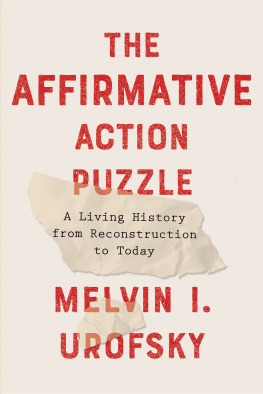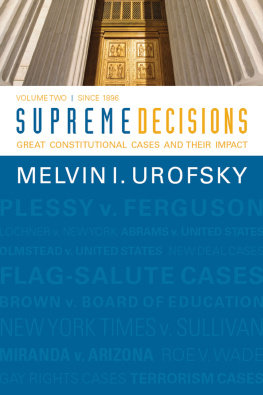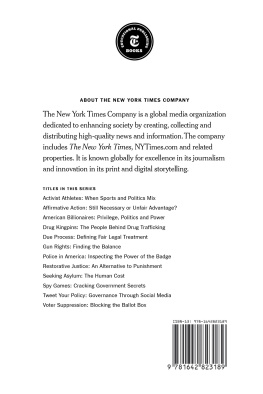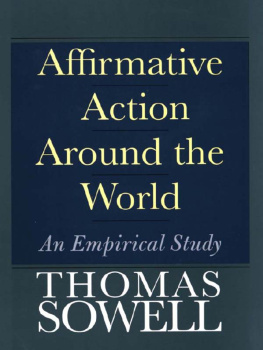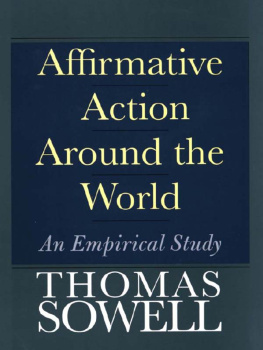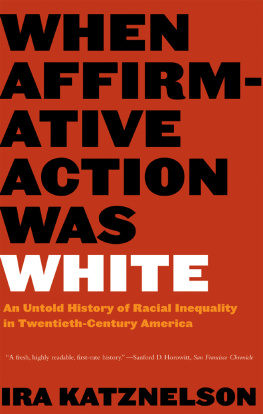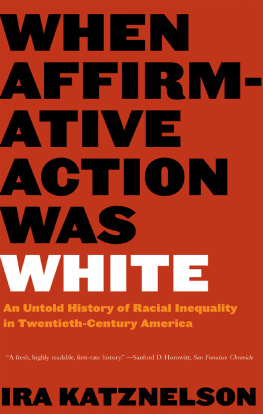Melvin I. Urofsky - The affirmative action puzzle: A Living History from Reconstruction to Today
Here you can read online Melvin I. Urofsky - The affirmative action puzzle: A Living History from Reconstruction to Today full text of the book (entire story) in english for free. Download pdf and epub, get meaning, cover and reviews about this ebook. year: 2020, publisher: Knopf Doubleday Publishing Group, genre: Politics. Description of the work, (preface) as well as reviews are available. Best literature library LitArk.com created for fans of good reading and offers a wide selection of genres:
Romance novel
Science fiction
Adventure
Detective
Science
History
Home and family
Prose
Art
Politics
Computer
Non-fiction
Religion
Business
Children
Humor
Choose a favorite category and find really read worthwhile books. Enjoy immersion in the world of imagination, feel the emotions of the characters or learn something new for yourself, make an fascinating discovery.
- Book:The affirmative action puzzle: A Living History from Reconstruction to Today
- Author:
- Publisher:Knopf Doubleday Publishing Group
- Genre:
- Year:2020
- Rating:5 / 5
- Favourites:Add to favourites
- Your mark:
- 100
- 1
- 2
- 3
- 4
- 5
The affirmative action puzzle: A Living History from Reconstruction to Today: summary, description and annotation
We offer to read an annotation, description, summary or preface (depends on what the author of the book "The affirmative action puzzle: A Living History from Reconstruction to Today" wrote himself). If you haven't found the necessary information about the book — write in the comments, we will try to find it.
The affirmative action puzzle: A Living History from Reconstruction to Today — read online for free the complete book (whole text) full work
Below is the text of the book, divided by pages. System saving the place of the last page read, allows you to conveniently read the book "The affirmative action puzzle: A Living History from Reconstruction to Today" online for free, without having to search again every time where you left off. Put a bookmark, and you can go to the page where you finished reading at any time.
Font size:
Interval:
Bookmark:
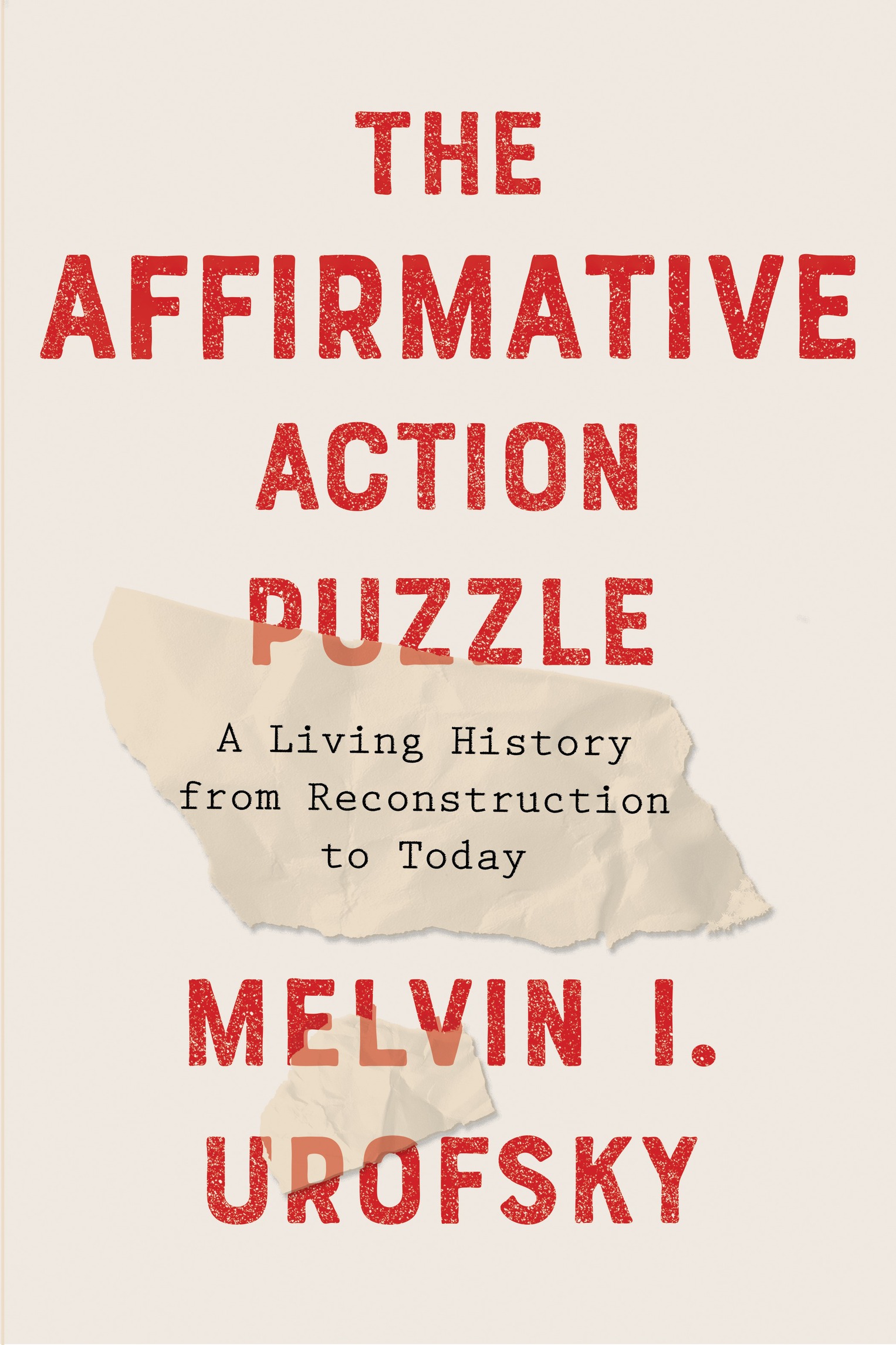
Dissent and the Supreme Court
Louis D. Brandeis: A Life
Money and Free Speech: Campaign Finance Reform and the Courts
Lethal Judgments: Assisted Suicide and American Law
Division and Discord: The Supreme Court Under Stone and Vinson, 19411953
Letting Go: Death, Dying, and the Law
A Conflict of Rights: The Supreme Court and Affirmative Action
A March of Liberty: A Constitutional History of the United States
A Voice That Spoke for Justice: The Life and Times of Stephen S. Wise
We Are One! American Jewry and Israel
American Zionism from Herzl to the Holocaust
Letters of Louis D. Brandeis (with David W. Levy)
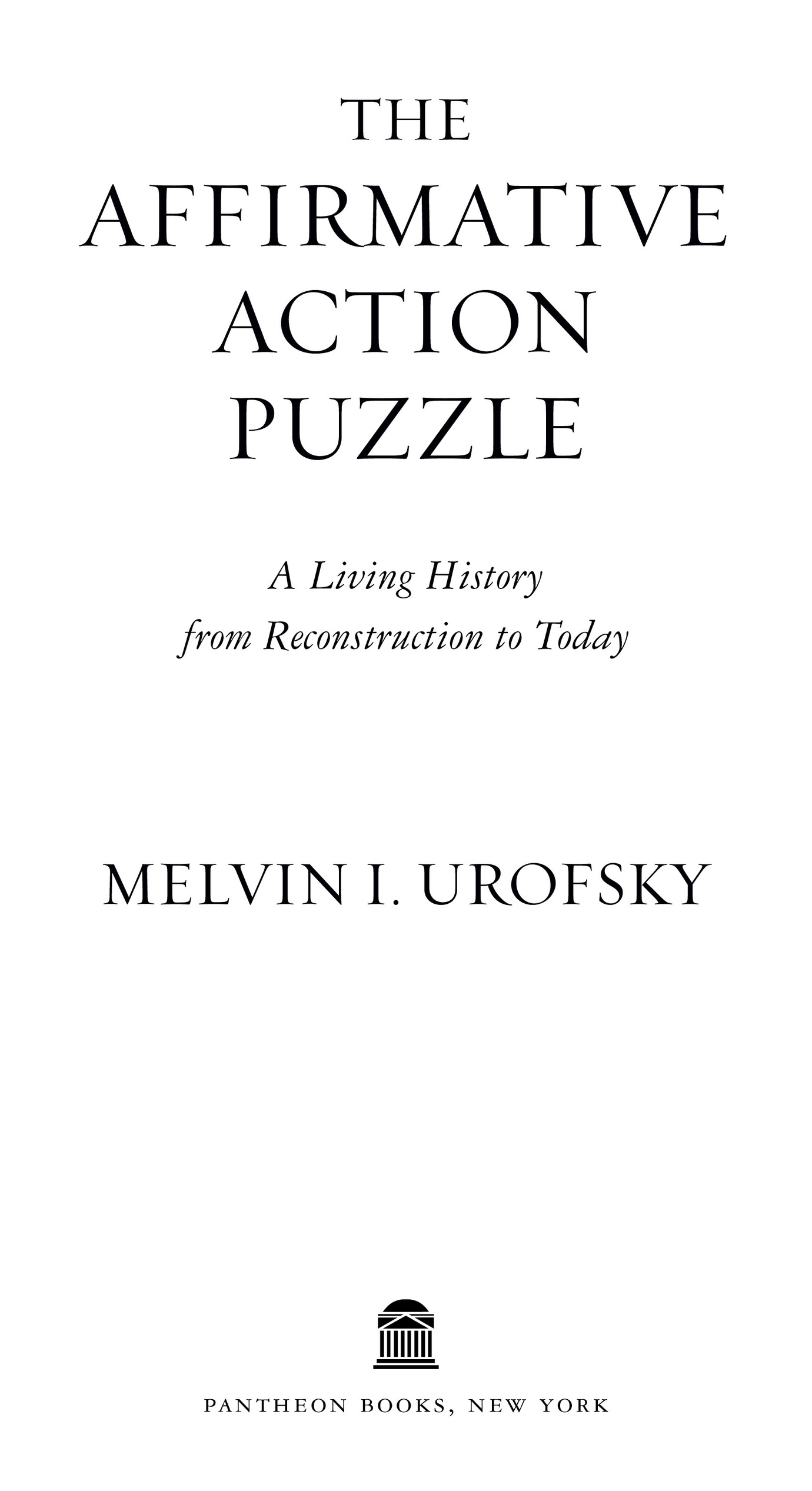
Copyright 2020 by Melvin I. Urofsky
All rights reserved. Published in the United States by Pantheon Books, a division of Penguin Random House LLC, New York, and distributed in Canada by Penguin Random House Canada Limited, Toronto.
Pantheon Books and colophon are registered trademarks of Penguin Random House LLC.
Library of Congress Cataloging-in-Publication Data
Name: Urofsky, Melvin I., author.
Title: The affirmative action puzzle / Melvin I. Urofsky.
Description: First edition. New York : Pantheon Books, 2020. Includes bibliographical references and index.
Identifiers: LCCN 2019016086 . ISBN 9781101870877 (hardcover : alk. paper). ISBN 9781101870884 (ebook)
Subjects: LCSH: Affirmative action programsUnited StatesHistory. Affirmative action programs in educationUnited StatesHistory. DiscriminationGovernment policyUnited StatesHistory. MinoritiesGovernment policyUnited StatesHistory.
Classification: LCC HF 5549.5 .A U 76 2020 | DDC 331.13 / 30973 dc | LC record available at lccn.loc.gov/2019016086
Ebook ISBN9781101870884
www.pantheonbooks.com
Cover photograph by MirageC/Moment/Getty Images
Cover design by Adalis Martinez
v5.4
ep
Pour toute la famille
The story is told that in a small shtetl in eastern Europe, two peasants got into a fight, and decided to take the matter to the rabbi to resolve the issue. The first farmer went into the rabbis study, poured his heart out, and when he finished, the rabbi said, My son, you are right.
Then the second man came in, and with equal fervor told his story, at the end of which the rabbi said, My son, you are right.
As soon as the second man went out the door, his wife, who had been listening to all this, said in exasperation, How could you do this? How could you tell both men that each is right?
To which the rabbi replied, My dear, you are also right.
This anecdote is the clue to my own feelings about affirmative action. Over a quarter century ago, I wrote a book about the only case the Supreme Court has ever decided concerning affirmative action for women, and I began that study with the same story. I was conflicted when I finished writing it and to some extent remain so to this day. On the one hand, only a bigot would oppose opening wide the doors of opportunity to groups that had previously been excluded because of race, ethnicity, gender, or disability. Having said that, I believe the real question is how to achieve this goal. There are many ways that corporations that once had lily-white male workforces have been able to develop plans to recruit capable women and minority members to work for them, and in doing so tapped into resources of talent they had previously ignored. Other firms, however, took what they thought would be the easy way, setting up quotas for how many African Americans they would hire, how many women, how many Hispanics, and so on. The use of quotas, even if the firms often used the euphemism of goals, offended many people, and as we shall see, this opposition ran across the political spectrum, from liberals to conservatives.
Opposition to affirmative action proved still stronger when colleges, universities, and professional schools adopted numbers-driven plans, even after they rephrased their goal from affirmative action to compensate for past discrimination to programs intended to achieve current diversity in their classrooms. As someone who has taught at the college and university level for many years, I value diversity, and I and many other teachers could tell countless tales about how much better a class can be when there are people in it who personally relate to the issues under discussion.
While the goal of diversity is praiseworthy, how one gets there matters a great deal. Some schools, like some corporations, managed the process carefully, while others, at least initially, just set up quotas. In public universities, this constituted state action, and thus opened the schools to lawsuits under the Equal Protection Clause of the Fourteenth Amendment. Here again, affirmative action, even if called diversity, aroused both support and condemnation that ranged from stalwart liberals to equally stalwart conservatives. It also split longtime allies, such as the Jewish community and its longtime support of African Americans seeking civil rights.
Ed Koch, the three-time mayor of New York (19781989), is a good example of how one could be conflicted about such programs. Peter L. Zimroth, who served as corporate counsel in Kochs administration, recalled,
Koch deeply believed several things. One is that the whole idea of quotas was an anathema. He was a poor, Jewish person growing up in the city. He believed, I think, that people, anybody, who had the drive and the will to accomplish something had a fair chance to accomplish it. He saw the way quotas kept people down, so he had a very strong opposition to quotas; I think he believed it would diminish the achievements of people who could achieve. If the currency was that anybody who was black or Hispanic got a job through affirmative action, it would just debase their achievements. On the other side, I think he also believed it was a necessity, both politically and morally, to have a diverse government and have a city where there were, in fact, opportunities; that you had to make opportunities for certain people.Both were sincerely held beliefs.
Unlike many authors on this subject, I have not attempted to make a case for or against affirmative action; this is not a polemic on either side. What I have tried to do is not only provide a historical context but also look at how affirmative action affected politics, the economy, higher education, the law, and the groups involved. While we normally associate African Americans with affirmative action and diversity, women and other racial and ethnic minorities have also played a significant role, and sometimes the goals of one group have conflicted with those of another. Who benefited and who suffered is not an easy question, nor is one that asks whether affirmative action succeeded. Similarly, what effect did affirmative action have on its intended beneficiariespeople of color, women, the disabled? The answer in all three cases depends on whom you ask. For example, both Clarence Thomas and Sonia Sotomayor were admitted to the Yale Law School under its affirmative action program. For many years, Justice Thomas claimed that the experience humiliated him, while Justice Sotomayor praised it for giving her a chance she might not have otherwise had. There are, as I said, arguments on all sides. The subject itself is a great puzzle.
Font size:
Interval:
Bookmark:
Similar books «The affirmative action puzzle: A Living History from Reconstruction to Today»
Look at similar books to The affirmative action puzzle: A Living History from Reconstruction to Today. We have selected literature similar in name and meaning in the hope of providing readers with more options to find new, interesting, not yet read works.
Discussion, reviews of the book The affirmative action puzzle: A Living History from Reconstruction to Today and just readers' own opinions. Leave your comments, write what you think about the work, its meaning or the main characters. Specify what exactly you liked and what you didn't like, and why you think so.

